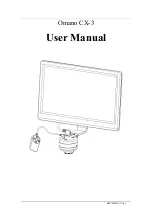
ATI
Q46H/65 Residual Chlorine Dioxide System
Part 5
– Sensor Assembly
30
O&M Manual
Rev-J (11/18)
6. Slowly screw the chamber onto the sensor body. A small amount of electrolyte will run out of
the hole from which the vent screw was removed. Place a paper towel around the sensor to
absorb the electrolyte overflow. The electrolyte is harmless and will not irritate skin. Tighten
the chamber until the o-ring at the top of the chamber is compressed. Once again, do not
use tools to tighten.
7. Shake excess electrolyte from the fill hole on the side of the sensor and replace the vent
screw.
The sensor is now ready for operation. The membrane should be stretched tightly across the tip
of the sensor.
CAUTION:
When handling the assembled sensor, do not set the sensor on its tip or damage
to the membrane will result. Severe impacts on the tip of the sensor from dropping
or other misuse may cause permanent damage to the sensor.
5.2
Optional pH Sensors
As mentioned previously, two optional pH sensors are available for use with the Q46H system,
one battery powered and one without an internal preamp. The pH sensors may be used for
continuous monitoring of both chlorine dioxide and pH. Both sensors are shipped with a
protective rubber boot containing a small amount of salt solution to keep the glass elements in
good condition and ready for use.
No special preparations are required for use of these electrodes. The protective boot should
remain in place until the system is ready for operation.
Do not remove the protective boot and
allow the sensor to sit in the air for an extended period of time. The pH electrodes MUST
remain wet.
When ready for operation, simply remove the rubber boot from the end of the sensor and place
the sensor into the inlet chamber of the ClO
2
overflow cell. It is placed directly above the sample
inlet tube. You will need to slide the flowcell chamber cover out of the way to put the pH sensor
in place.
















































